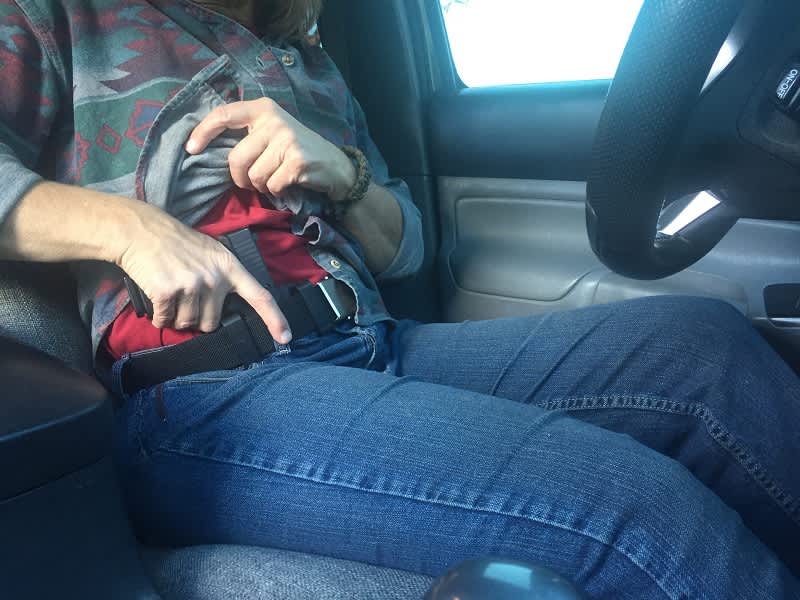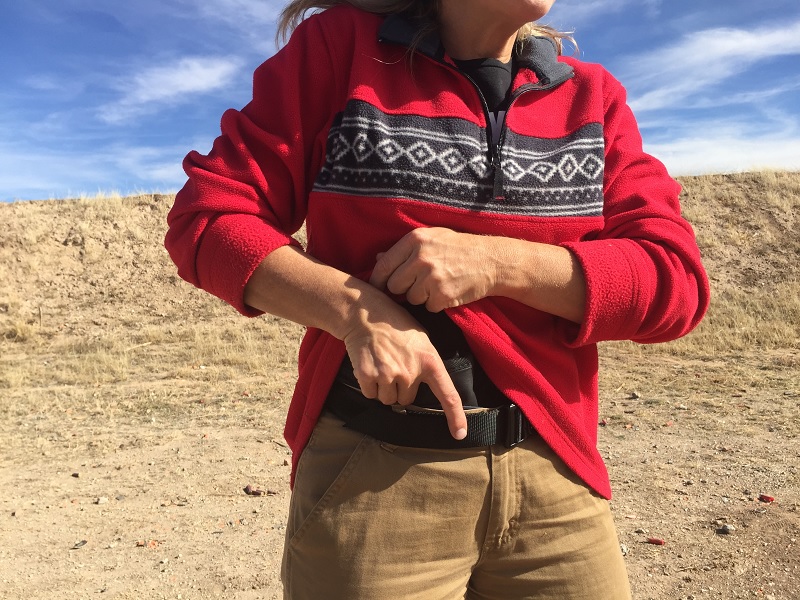So You Want to Carry Concealed: Five Mistakes to Avoid
Eve Flanigan 07.24.19

Headlines say people are obtaining concealed carry permits in record numbers. That’s mostly good news; there is plenty of evidence to show that public places are safer when civilians without criminal histories go armed. If you’re beginning the journey of carrying concealed, I’d like to share these five mistakes I commonly see new carriers make, along with suggestions for correcting them.

Be dead-set on your handgun of choice.
As you spend time (and you are, right?) practicing your draw, dry firing, and making time for range practice, you’ll gain intimate knowledge of the operation of your firearm. Do its mechanical and structural features make it easy or hard to hold, aim, and do normal manipulations like engage and disengage the safety, press the trigger, and perform reloads? During live fire, does the gun cycle reliably with your chosen ammunition? Are you happy with its round capacity? Can you see the sights well against a dark background?
If you’re doing your job and getting some deliberate practice in, even if it’s centered around a few minutes of dry fire every week, you’ll know where the strengths and weaknesses are of you and your firearm as unit. Don’t allow love for this inanimate object cloud your honest assessment about whether this gun is a good choice for your everyday carry. Many great guns aren’t suited for concealment due to size, complexity of operation, or shape. What you regard as acceptable may change as your carry method, skill level, or even job evolve. Stay objective.

Assume that first holster is going to work perfectly, always.
Most experienced concealed carriers have a box full of holsters that, for some predictable reason, didn’t work out as advertised or anticipated. Some deep-concealment methods look great in a catalog but are too abrasive or hot for everyday use. Some holsters that seem very easy fail to keep the gun where it belongs as you move around.
Minimum criteria for a holster is that it must shield the trigger guard in a manner that’s impenetrable by outside objects—pens, dog claws, and toddler fingers and toes, for example, are things that may exist in your routine that can never be allowed to enter the trigger guard when the gun is worn. An adequate holster will also keep the gun from falling out. It seems obvious but there is a spectrum of retention on holster types, some of which is so sloppy as to be dangerous, and some that is appropriate for some lifestyles but not others. Finally, the holster, when worn, must keep the gun oriented in space so that you don’t have to look or fiddle around to get your hand on it and draw.
Don’t blow the bank on your first holster; you’ll likely go through many. For experimenting with inside waistband or pocket carry, one economical choice that covers the safety requirements for lots of people is the Comfort Cling by Clinger Holsters. While it won’t retain the gun under all conditions, I have found it both comfortable and effective for much of what I do, so long as I wear a belt or tight drawstring around my waist.
If you’re committed to a carry method like having a sheathed gun in your front pants pocket or ankle carry, consider what it will take to draw while driving or sitting at the office. Decide whether the more effective concealment of these methods offsets the time delay and obvious effort in drawing the handgun.
Forget you’re wearing a gun.
It sounds obvious, but many people say they’ve forgotten about the gun that’s on their person. Especially if it’s been revealed that you’re armed, maybe by an inadequate concealment method or your own mouth, remember there’s always at least one gun on the scene at whatever events you find or put yourself in! While it’s unusual for a criminal to steal and use a law-abiding person’s gun, it has happened. The first step in preventing this is to maintain awareness—both of your environment and the location of the gun on or near you.
If security camera evidence means anything, most of those criminal gun grabs in the recent past appear to have occurred when the armed person was wearing their gun on the waist, behind their front, somewhere between 3- and 9-o’clock on the waist dial. Consider that if you wear a gun there, while it is comfortable, it will tend to stick out under clothing, especially if you bend or sit and then stand back up. Decide if you’re ready to deal with the additional chore of bending creatively in public if you’re going to wear a gun behind your back.

Talk to “everybody” about it.
It’s called “concealed carry” for a reason. Lots of people enjoy the feeling they get from talking about their armed status. Whether neighbors, coworkers, or others in the community are supportive or not, discussing details about your carry habits or, worse, bragging about “what I’d do if X happened to me,” flapping your gums can come back to bite you. Whether it’s because that co-worker went home and talked about where you keep your firearm within earshot of a criminally-inclined family member, or because you posted on social media about being ready to test out your new 12 gauge on a local burglar, loss of your gun, income, and quality of life can result from running your mouth, especially if you find yourself in court over a defensive gun use. On the other hand, there’s virtually no downside to being discreet. Loose lips sink ships!
Carry only when it’s convenient.
Some people feel a sense of accomplishment after obtaining a concealed carry permit, or winning the fight for Constitutional carry in their state, and stop there. Or they keep their firearm in their car’s console, and leave it there as they navigate daily activities. The gun that’s not on you cannot protect you! Figure out a way to wear the gun wherever it’s legally possible, preferably concealed for the reasons named in item 4.
This is perhaps the biggest obstacle to concealed carry—figuring out what’s worth compromising to make a carry system work. For me, as I began to understand the limitations and dangers of purse carry, I had to change my style of dress and began wearing belts in order to have a gun with me. Along with that came the transition to a more compact firearm (okay, it was six or seven) that can fit between my hips and legs when sitting….not to mention several holsters tried and discarded until I found ones that work for my body shape and daily routine.
And that brings this discussion full circle. Effective concealed carry is the best way to protect yourself and loved ones from violent crime. Doing so requires some effort, but it’s my experience that knowing I’m capable of self-protection is worth it. Conversely, staying unarmed where the option exists can be viewed as a decision to be a victim. As Lt. Col. (Retired) David Grossman says, “your lifestyle should be comforting, not comfortable.”

